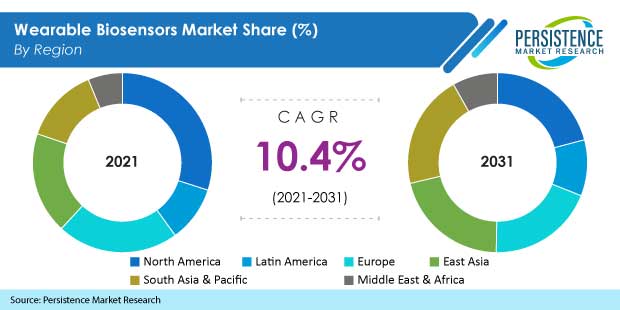The global wearable biosensors market is estimated to accelerate a high CAGR of 10.4% over the forecast period (2021-2031). As such, the market is set to expand around 2.4X and close in on a valuation of US$ 33.1 Bn by 2031.
The future of wearable biosensors looks attractive with opportunities across different sectors such as healthcare, military, agriculture, and food & beverages. Major drivers for this market happen to be growth of Internet of Things (IoT), increasing need for wearable devices, and miniaturization of sensors.
As the society is moving toward a connected world, sensors are increasingly being adopted across various applications. Many of these applications require various sensors in a small footprint with no degradation of performance and often with very low power requirements. With increasing number of applications requiring smaller sensors, there has been substantial rise in demand for miniaturization of sensors, thereby increasing demand for wearable biosensors.
You can request sample here @ https://www.persistencemarketresearch.com/samples/16522

Get A Customized Scope To Match Your Need Ask An Expert – sales@persistencemarketresearch.com
Market players are involved in collaborations and acquisitions, and also coming out with advanced products to increase their industry share.
- In May 2020, Koninklijke Philips N.V. introduced the Philips Biosensor BX100. This product is designed to address a new approach to vital sign measurements, supporting surveillance of higher acuity patients moving from intensive care units to lower acuity general care areas of a hospital. The biosensor has been widely used for clinical surveillance of COVID-19 patients in hospitals for monitoring their health and recovery.
- In Feb 2021, Phillips-Medisize, a Molex company, collaborated with Subcuject to introduce a wearable bolus injector to market. The new Wearable Osmotic Bolus Injector is designed to be a low-cost, patient-friendly, prefilled wearable injector for single use. The product uses osmosis to generate force to complete a full injection cycle, requiring minimal components, which reduces development time and costs.
- In November 2020, VitalConnect Inc launched the VitalPatch RTM cardiac monitoring solution for patients who require extended Holter monitoring. VitalPatch RTM monitors 21 cardiac arrhythmias through a unique AI-based ECG analysis solution and captures data on four key vital signs, providing a more complete view of a patient’s condition.
Get Methodology Report here @ https://www.persistencemarketresearch.com/methodology/16522
Key Takeaways from Market Study
- Demand for sensor patches, among type, is estimated to surge. However, embedded sensors are estimated to continue to hold a significant market share through 2031.
- Healthcare & medical application is expected to emerge as a high-growth market. However, environmental monitoring application is estimated to dominate the market share through 2031.
- By product, wearable electrochemical biosensors are currently leading the market. However, demand for wearable piezoelectric biosensors is likely to expand at a robust CAGR of nearly 14% through 2031.
- The South Asia & Pacific market is expected to register a high CAGR owing to growing demand for various wearable biosensors for monitoring health and quality of food & beverages across the region.
- The market for wearable biosensors in Japan and India is expected to surge at growth rates of around 14% and 19%, respectively.
“Wearable biosensor providers are focusing on developing single-walled carbon nanotube based electrochemical biosensors for detecting microorganisms that cause respiratory diseases,” says a Persistence Market Research analyst.
Increasing Demand for Wearable Biosensors in Food & Beverage Sector to Propel Market Growth
Growth of the food & beverage sector has a significant impact on the market for wearable biosensors. Increasing number of food & beverage companies and rising demand for canned and packaged food are important factors driving market growth.
Sensing devices are being increasingly used in the packaging sector to improve industrial efficiency, convenience, and precautions. Furthermore, wearable biosensors help in improving the sensitivity, specificity, and detection limit of chemical analysis of food & beverages, thereby generating high demand for wearable biosensors in the food industry.
More Valuable Insights
Persistence Market Research’s report on the wearable biosensors market is segmented into four major sections – type (sensor patches and embedded sensors), product (wearable electrochemical biosensors, wearable optical biosensors, wearable piezoelectric biosensors, wearable thermal biosensors, and others), application (healthcare & medical, environmental monitoring, military & defense, food & agriculture, and others), and region (North America, Latin America, Europe, East Asia, South Asia & Pacific, and the Middle East & Africa), to help readers understand and evaluate lucrative opportunities in the market.
You can purchase this report here @ https://www.persistencemarketresearch.com/checkout/16522
About Us :- Persistence Market Research
Contact us:
Persistence Market Research
Address – 305 Broadway, 7th FloorNew York City,
NY 10007 United States
U.S. Ph. – +1-646-568-7751
USA-Canada Toll-free – +1 800-961-0353
Sales – sales@persistencemarketresearch.com
Website – https://www.persistencemarketresearch.com